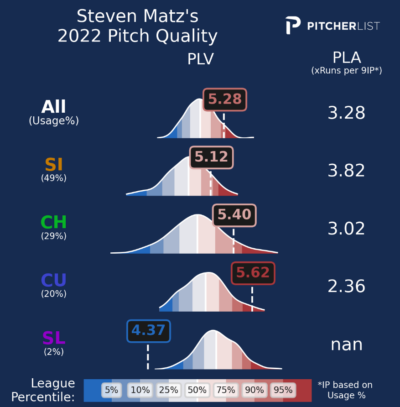Ah, yes, everyone’s favorite pitching category, wins. Just ask Aaron Nola, who, despite pitching for the team that won the NL pennant while finishing second in the NL with 205 IP, had more losses (13) than wins (11).
Last year, only 27 pitchers threw 180 or more innings. The league average was 5.2 IP (not to be confused with five and 2/3) and 85 pitches per start.
In 2010, 71 pitchers threw 180 or more innings, and the league average was 6.0 IP and 97 pitches per start.
Just an absolutely random comparison and nothing new, but I think it’s fun to see how things change. Wins are a tough category to scavenge for. Basically, I’m searching for pitchers with low walk rates who are ideally on winning teams. We’ll survey some options past pick 200 in NFBC Draft Champions over the past month (2/2 – 3/2). As a fair warning, there will be boring veterans galore. With a little luck, maybe we can find this year’s Kyle Wright.
232.35 ADP
2022 Stats (172.0 IP): 12-7, 5.23 ERA, 1.42 WHIP, 13.8% K-BB%
José Berríos had a dreadful season that included a career-high 199 hits allowed, and a career-low K rate of 19.8%. As you’d expect, Statcast paints a bleak picture across the board.
What about the new PLV stuff? He was in the top 1% percentile in “hit luck,” meaning he surrendered more hits than he probably should have based on the PLV model. There are, of course, things that this doesn’t account for, team defense being one. The point here is that Berríos popped on last year’s list. For reference, Tony Gonsolin was on the other side of the spectrum, i.e., he was probably lucky. For more on PLV and all that it incorporates, be sure to check Nick’s terrific primer.
So maybe a little bad luck on balls in play, but that doesn’t explain away a 5.24 ERA. At the very least, his curveball (31% thrown) didn’t disappear. Last year, it recorded a PLV in the 86th percentile. His four-seamer (28% thrown) was his worst pitch, with a PLV in the 61st percentile and a .410 xwOBA allowed. However, his sinker performed noticeably better, with a PLV in the 83rd percentile.
It seems like his four-seamer is at least part of the problem. It’s not the type of four-seamer we like for fantasy purposes, i.e., swings-and-misses at the top of the zone. Instead, he used it more when he was behind in the count. And it got demolished. Lefties produced a .497 wOBA (!!) against it last year. And that was the pitch he threw most frequently to lefties last year at 32.7%. Last August, FanGraphs’ Ben Clemens posited a simple solution; Throw more sinkers.
Based on last year’s results, getting away from the four-seamer might be a step in the right direction. Should we look at his mix so far this spring? Of the 36 pitches he threw in his first spring start(2/28), 17 were sinkers (47%), and only four were four-seamers (11%). It’s one spring start, so it probably means nothing. And sure enough, he showed an even mix of sinkers and four-seamers (23%) in his next start. Kyle Schwarber found one of the latter to his liking, a two-run shot to right. That four-seamer is trouble.
The Jays are committed to him long-term, so you’d figure that getting him right was an off-season priority. Sure enough, Berríos made several mechanical adjustments over the winter. The hope is that the extra work breathes life into a once-reliable starter with a 3.66 ERA and 1.17 WHIP over his previous three seasons (455.1 IP). Whether or not it happens is, of course, anyone’s guess. But I think there’s a path back to his former self, and at this ADP, he makes sense as a buy-low.
318.98 ADP
2022 Stats (157.1 IP): 12-5, 3.49 ERA, 1.19 WHIP, 13.4% K-BB%
So what stands out about Taijuan Walker? Mostly, it’s about taking the ball every fifth day and having a great Phillies lineup in support. Ben Palmer mentioned Walker’s splitter in his money pitches article. Other than that, Walker doesn’t stand out much.
Walker’s 13.4% K-BB% was 45th among the 62 starters who threw over 150 IP. His fastball velocity dropped from 94.5 to 93.7 and allowed a .350 xwOBA. In short, you don’t have to dust off the microscope to see his ERA/WHIP regressing.
But I really liked that he upped his splitter usage from 14.3% to 27.6%. That pitch carried him, he threw it for strikes and got batters to chase. He also cut his walk rate from 8.4% to 6.9%.
As is, Walker might not offer the upside you’re searching for with a perfectly boring 20.3% K rate, and the seemingly impending regression that’s etched into his ADP. But, maybe the subtle improvements we saw last year are a springboard. With how increasingly malleable pitchers are now, I’m always at least a little curious when we see changes in scenery. It won’t cost much to find out.
287.61 ADP
2022 Stats (134.2 IP): 5-8, 3.83 ERA, 1.21 WHIP, 11.3% K-BB%
Some parallels with Walker. A former top prospect who is now certifiably ancient at 30. Although, unlike Walker, Noah Syndergaard didn’t have the advantage of a standout pitch to save him. His once stalwart slider returned an 8.4% SwStr rate, which led to his K-rate plummeting to a career-low 16.8%. And the heater averaged around 93.6, a far cry from his halcyon days as a young phenom in Queens. Although, his changeup did register a decent 14.4% SwStr rate. So there’s that, at least.
The narrative is that he’s now with the Dodgers. Tyler Anderson and Andrew Heaney thrived there last year and have since parlayed their renaissance into multi-year deals with the Angels and Rangers. One thing is certain: the Dodgers need innings with both of them gone.
Enter Syndergaard, who is now a year further removed from TJ. Might he be the latest reclamation project? So far, his quest to regain his fastball hasn’t gone as planned. In his first spring start, the results weren’t ideal. His fastball topped at 93. He was candid afterward and admitted that it’s not where he wants to be. Still, it’s early, and he’s working on ironing out his delivery so we’ll see if he progresses in his next few appearances.
376.13 ADP
2022 Stats (127.1 IP): 11-2, 3.32 ERA, 1.12 WHIP, 14.2% K-BB%
Our theme of familiar faces in different places continues with the former Cardinal, Met, Ray, and now Red Sox, Michael Wacha. Given their lack of pitching depth, the signing made sense for the Padres. Shortly afterward, Joe Musgrove got hurt. So the Padres need innings from Wacha even more.
Last year, Wacha’s changeup was as good as ever and returned a 20.5% SwStr rate. The rest of the arsenal, though, is sketchy. As Nick Pollack mentioned in his top 300 SPs, spotting the regression monster’s shadow is easy. His cutter was very fortunate.
Still, like Miles Mikolas last year, sometimes it’s just as simple as throwing strikes with a good supporting cast. We know Wacha isn’t going to pile up strikeouts, but one thing he’s very good at is throwing strikes; Over the past two seasons (286 IP), his 4.8% BB walk rate would be tied with Max Scherzer for third among qualified SPs.
As Ben Rosener mentioned, the shift from Fenway to Petco Park is one that should work in his favor. So should a lineup that just added Xander Bogaerts and a hopefully healthy Fernando Tatis Jr. Wacha’s upside isn’t much, so feel free to ignore him in shallow or standard leagues, but he could turn out to be a useful streaming option in deep leagues.
280.14 ADP
2022 Stats: (164.1 IP): 13-8, 3.94 ERA, 1.17 WHIP, 14.1% K-BB%
The Astros’ top prospect, Hunter Brown, is the more exciting option for strikeouts. But I think he might be a candidate to be over-drafted. His walk rate was high last year at 10.6% BB across 106 IP in Triple-A. Despite sitting just under 97, his fastball returned only an 8.5% SwStr rate. Granted, it was only 20 innings, but it’s enough to make me hesitate, especially with his ADP likely to surge, given that it’s the Astros.
The better, albeit more boring value, might be Urquidy. There’s not much to say about Urquidy in that he doesn’t have a standout pitch, but he does offer a solid floor, given last year’s 5.6% walk rate. He might not have strikeout upside, but the 1.10 WHIP over his past two seasons (271 IP) certainly plays.
324.33 ADP
2022 Stats (48 IP): 5-3, 5.25 ERA, 1.25 WHIP, 21.3% K-BB%
A shoulder impingement and a torn MCL de-railed Matz’s first year in St. Louis. And he had a couple of bad starts against the Giants and Pirates that torched his ERA. It makes him easy to forget, well, that, and he’s 31 with a career 4.30 ERA and 1.32 WHIP.
Still, he’s got a spot in the rotation backed by one of the best lineups in the NL. I’ll remain blissfully ignorant of last year’s ERA and instead focus on his career-best 21.3% K-BB. His sinker returned an excellent 14% SwStr rate. And his curveball and changeup had a PLV in the 95th percentile. Hey, maybe he was on to something?

246.35 ADP
2022 Stats (177.1 IP): 14-5, 3.91 ERA, 1.13 WHIP, 16.3% K-BB%
Taillon’s K-rate dropped to 20.7% last year, and that’s not what you want. But he was among only 39 pitchers last year to throw over 170 innings. And he tied Max Fried and Justin Verlander for the fourth-lowest BB% rate among qualified SPs at 4.4%. That’s not a bad way to get wins. The Cubs won’t offer the same run support he got with the Yankees last year, but I like his chances of providing more K’s this year. He added a new sweeping slider this past offseason, broke it out in his first spring start against the Guardians, and made Steven Kwan, who doesn’t strike out, do this.
Jameson Taillon, Filthy Back Foot Slider…and Sword. ⚔️ pic.twitter.com/C6lNnRFyZD
— Rob Friedman (@PitchingNinja) February 27, 2023
Photo by Cliff Welch/Icon Sportswire | Adapted by Doug Carlin (@Bdougals on Twitter)

